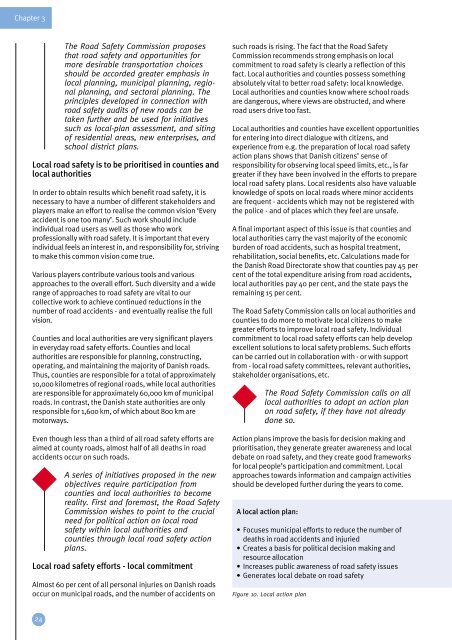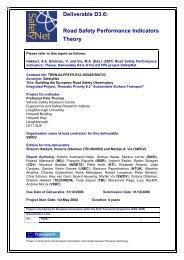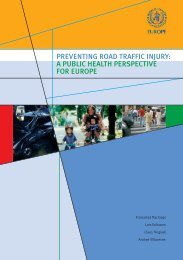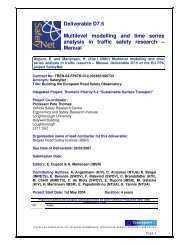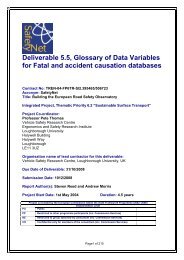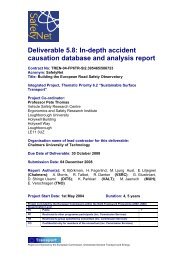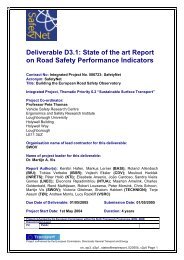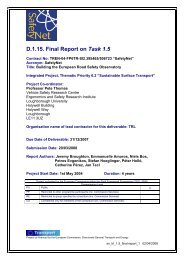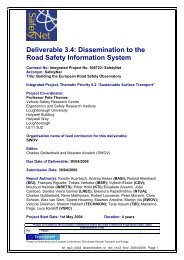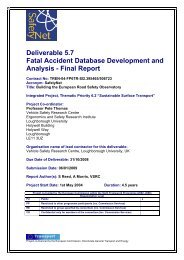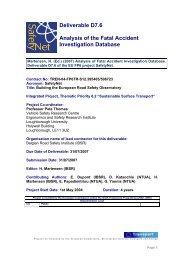Every Accident is One Too Many Every Accident is One ... - UNECE
Every Accident is One Too Many Every Accident is One ... - UNECE
Every Accident is One Too Many Every Accident is One ... - UNECE
Create successful ePaper yourself
Turn your PDF publications into a flip-book with our unique Google optimized e-Paper software.
Chapter 3<br />
The Road Safety Comm<strong>is</strong>sion proposes<br />
that road safety and opportunities for<br />
more desirable transportation choices<br />
should be accorded greater emphas<strong>is</strong> in<br />
local planning, municipal planning, regional<br />
planning, and sectoral planning. The<br />
principles developed in connection with<br />
road safety audits of new roads can be<br />
taken further and be used for initiatives<br />
such as local-plan assessment, and siting<br />
of residential areas, new enterpr<strong>is</strong>es, and<br />
school d<strong>is</strong>trict plans.<br />
Local road safety <strong>is</strong> to be priorit<strong>is</strong>ed in counties and<br />
local authorities<br />
In order to obtain results which benefit road safety, it <strong>is</strong><br />
necessary to have a number of different stakeholders and<br />
players make an effort to real<strong>is</strong>e the common v<strong>is</strong>ion ‘<strong>Every</strong><br />
accident <strong>is</strong> one too many’. Such work should include<br />
individual road users as well as those who work<br />
professionally with road safety. It <strong>is</strong> important that every<br />
individual feels an interest in, and responsibility for, striving<br />
to make th<strong>is</strong> common v<strong>is</strong>ion come true.<br />
Various players contribute various tools and various<br />
approaches to the overall effort. Such diversity and a wide<br />
range of approaches to road safety are vital to our<br />
collective work to achieve continued reductions in the<br />
number of road accidents - and eventually real<strong>is</strong>e the full<br />
v<strong>is</strong>ion.<br />
Counties and local authorities are very significant players<br />
in everyday road safety efforts. Counties and local<br />
authorities are responsible for planning, constructing,<br />
operating, and maintaining the majority of Dan<strong>is</strong>h roads.<br />
Thus, counties are responsible for a total of approximately<br />
10,000 kilometres of regional roads, while local authorities<br />
are responsible for approximately 60,000 km of municipal<br />
roads. In contrast, the Dan<strong>is</strong>h state authorities are only<br />
responsible for 1,600 km, of which about 800 km are<br />
motorways.<br />
Even though less than a third of all road safety efforts are<br />
aimed at county roads, almost half of all deaths in road<br />
accidents occur on such roads.<br />
A series of initiatives proposed in the new<br />
objectives require participation from<br />
counties and local authorities to become<br />
reality. First and foremost, the Road Safety<br />
Comm<strong>is</strong>sion w<strong>is</strong>hes to point to the crucial<br />
need for political action on local road<br />
safety within local authorities and<br />
counties through local road safety action<br />
plans.<br />
Local road safety efforts - local commitment<br />
Almost 60 per cent of all personal injuries on Dan<strong>is</strong>h roads<br />
occur on municipal roads, and the number of accidents on<br />
such roads <strong>is</strong> r<strong>is</strong>ing. The fact that the Road Safety<br />
Comm<strong>is</strong>sion recommends strong emphas<strong>is</strong> on local<br />
commitment to road safety <strong>is</strong> clearly a reflection of th<strong>is</strong><br />
fact. Local authorities and counties possess something<br />
absolutely vital to better road safety: local knowledge.<br />
Local authorities and counties know where school roads<br />
are dangerous, where views are obstructed, and where<br />
road users drive too fast.<br />
Local authorities and counties have excellent opportunities<br />
for entering into direct dialogue with citizens, and<br />
experience from e.g. the preparation of local road safety<br />
action plans shows that Dan<strong>is</strong>h citizens’ sense of<br />
responsibility for observing local speed limits, etc., <strong>is</strong> far<br />
greater if they have been involved in the efforts to prepare<br />
local road safety plans. Local residents also have valuable<br />
knowledge of spots on local roads where minor accidents<br />
are frequent - accidents which may not be reg<strong>is</strong>tered with<br />
the police - and of places which they feel are unsafe.<br />
A final important aspect of th<strong>is</strong> <strong>is</strong>sue <strong>is</strong> that counties and<br />
local authorities carry the vast majority of the economic<br />
burden of road accidents, such as hospital treatment,<br />
rehabilitation, social benefits, etc. Calculations made for<br />
the Dan<strong>is</strong>h Road Directorate show that counties pay 45 per<br />
cent of the total expenditure ar<strong>is</strong>ing from road accidents,<br />
local authorities pay 40 per cent, and the state pays the<br />
remaining 15 per cent.<br />
The Road Safety Comm<strong>is</strong>sion calls on local authorities and<br />
counties to do more to motivate local citizens to make<br />
greater efforts to improve local road safety. Individual<br />
commitment to local road safety efforts can help develop<br />
excellent solutions to local safety problems. Such efforts<br />
can be carried out in collaboration with - or with support<br />
from - local road safety committees, relevant authorities,<br />
stakeholder organ<strong>is</strong>ations, etc.<br />
The Road Safety Comm<strong>is</strong>sion calls on all<br />
local authorities to adopt an action plan<br />
on road safety, if they have not already<br />
done so.<br />
Action plans improve the bas<strong>is</strong> for dec<strong>is</strong>ion making and<br />
priorit<strong>is</strong>ation, they generate greater awareness and local<br />
debate on road safety, and they create good frameworks<br />
for local people’s participation and commitment. Local<br />
approaches towards information and campaign activities<br />
should be developed further during the years to come.<br />
A local action plan:<br />
• Focuses municipal efforts to reduce the number of<br />
deaths in road accidents and injuried<br />
• Creates a bas<strong>is</strong> for political dec<strong>is</strong>ion making and<br />
resource allocation<br />
• Increases public awareness of road safety <strong>is</strong>sues<br />
• Generates local debate on road safety<br />
Figure 10. Local action plan<br />
24


